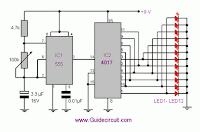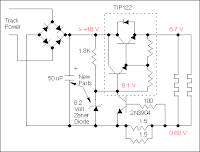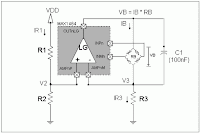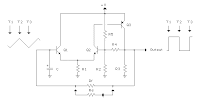Descrete Multistage Light Sequencer Circuit
The drawing below illustrates a multistage light sequencer using
descrete parts and no integrated circuits. The idea is not new
and I hear a similar circuit was developed about 40 years ago
using germanium transistors. The idea is to connect the lights so
that as one turns off it causes the next to turn on, and so forth.
This is accomplished with a large capacitor between each stage
that charges when a stage turns off and supplies base current to
the next transistor, thus turning it on. Any number of stages can
be used and the drawing below illustrates 3 small Christmas lights
running at about 5 volts and 200mA. The circuit may need to be
manually started when power is applied. To start it, connect a
momentary short across any one of the capacitors and then
remove the short. You could use a manual push button to do this.

16 Stage LED Sequencer Circuit
The circuit below uses a hex Schmitt Trigger inverter (74HC14)
The circuit below uses a hex Schmitt Trigger inverter (74HC14)
and two 8 bit Serial-In/Parallel-Out shift registers (74HCT164 or
74HC164) to sequence 16 LEDs. The circuit can be expanded to
greater lengths by cascading additional shift registers and
connecting the 8th output (pin 13) to the data input (pin 1) of the
succeeding stage. A Schmitt trigger oscillator (74HC14 pin 1 and 2)
produces the clock signal for the shift registers, the rate being
approximately 1/RC. Two additional Schmitt Trigger stages are
used to reset and load the registers when power is turned on.

60 Light Sequencer Circuit using a Matrix
The circuit below illustrates using a 10x10 matrix to sequence up
to 100 LEDs with just three ICs and 20 transistors. The two 4017
decade counters control the 10 rows and 10 columns so that one
LED is selected depending on the output of the decade counters.
The LED circuit is drawn showing 25 LEDs and 10 transistors but
can be expanded up to a 100 by using sucessive stages of the
4017 counters.
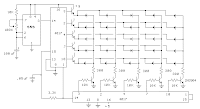
more
LED sequencer
The model 4017 integrated circuit is a CMOS counter with ten
output terminals. One of these ten terminals will be in a "high"
state at any given time, with all others being "low," giving a
"one-of-ten" output sequence. If low-to-high voltage pulses are
applied to the "clock" (Clk) terminal of the 4017, it will increment
its count, forcing the next output into a "high" state. With a 555
timer connected as an astable multivibrator (oscillator) of low
frequency, the 4017 will cycle through its ten-count sequence,
lighting up each LED, one at a time, and "recycling" back to the
first LED. The result is a visually pleasing sequence of flashing
lights. Feel free to experiment with resistor and capacitor values
on the 555 timer to create different flash rates



